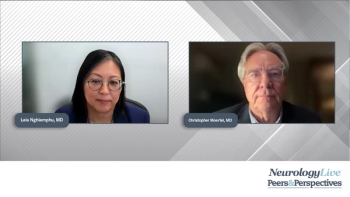
Benzodiazepines and Antipsychotics Tied to Higher Mortality in Hospice Patients With Dementia
Key Takeaways
- Benzodiazepine and antipsychotic use in ADRD patients is linked to increased 180-day mortality risk, with hazard ratios of 1.41 and 1.16, respectively.
- The study underscores the need for dementia-specific hospice prescribing guidelines and nonpharmacologic alternatives to manage symptoms in ADRD patients.
A recent study highlights the increased mortality risk linked to benzodiazepine and antipsychotic use in hospice patients with dementia, urging new prescribing guidelines.
A recently published, national case-control study of more than 100,000 nursing home residents with Alzheimer disease and related dementias (ADRD) revealed that benzodiazepine and antipsychotic use is associated with increased risk of 180-day mortality. Overall, the findings underscored the need for dementia-specific hospice prescribing guidelines and emphasize that clinicians should carefully weigh the risks and benefits of benzodiazepine and antipsychotic use in this population.1
Published in JAMA Network Open, the retrospective, case-control study utilized national Medicare claims and Minimum Data Set assessments from July 2014 to September 2018 from US nursing homes that provided long-term care. The analysis first comprised 139,103 participants (75.8% female; mean age, 87.6 [SD, 7.7] years) with ADRD who were newly enrolled in hospice and had no benzodiazepine or antipsychotic use within the prior 6 months.
Led by Lauren B. Gerlach, DO, MS, a geriatric psychiatrist and assistant professor in the Department of Psychiatry at the University of Michigan, 26,872 matched pairs were included in the benzodiazepine cohort and 10,240 in the antipsychotic cohort. All told, new initiation of benzodiazepine or antipsychotic use while enrolled in hospice was associated with a 41% and 16% increased risk of 180-day mortality, respectively.
To ensure accurate medication exposure assessment, patients with inpatient or skilled nursing days exceeding 20% of baseline days were excluded. In addition, those who received either drug only in the last 3 days of life or with hospice stays under 3 days were also excluded. Heading into the study, baseline characteristics were well balanced between medication users and nonusers, according to study authors.
Overall, the mean hospice length of stay was 136.4 (SD, 186.5) days and 154.0 (SD, 197.5) days for those with incident benzodiazepine and antipsychotic use, respectively. In unadjusted comparisons, 73.58% of those who initiated benzodiazepine died by 180 days compared with 58.3% of nonusers. Similar, but less drastic differences were observed for those who initiated antipsychotics (70.7% vs 63.3%).
Historically, benzodiazepines and antipsychotics have been used in hospice settings to help manage agitation, anxiety, and delirium; however, both classes are known to be associated with significant risks in older adults with ADRD. This information, combined with the new findings from this study, reinforces the concerns about the medication use of these therapies for nursing home residents.
READ MORE:
"This is particularly important in hospice given that decedents with ADRD in hospice are 3 times more likely to receive these medications compared with those not in hospice," Gerlach et al wrote. "Together, these data underscore the need for dementia-specific hospice prescribing guidelines, investment in nonpharmacologic alternatives, and Medicare policy reform to track and inform safe medication use in hospice."
At 180 days, the HR of death for those on benzodiazepines was 1.41 (95% CI, 1.38-1.44), while the HR for those on antipsychotics was a more modest but significant 1.16 (95% CI, 1.12-1.20) compared with nonusers. In propensity score–weighted Cox proportional hazards regression models, the association between initiation of medication use and mortality persisted (benzodiazepine HR, 1.92 [95% CI, 1.88-1.96]; antipsychotic HR, 1.86 [95% CI, 1.79-1.94]).
Additional data from the sensitivity analyses revealed consistent findings when restricting to patients with a primary diagnosis of ADRD (benzodiazepine: HR, 1.31 [95% CI, 1.27-1.36]; antipsychotic: HR, 1.20 [95% CI, 1.13-1.27]). Notably, cumulative medication exposure showed that each additional prescription fill was associated with increased 180-day mortality for benzodiazepines (HR, 1.15; 95% CI, 1.12-1.18) and antipsychotics (HR, 1.06; 95% CI, 1.01-1.10).
The study authors suggested that more standardized hospice prescribing guidance in ADRD may be beneficial, considering that prescribing patterns vary and the decision to use either drug class may depend on agency practice norms rather than clinical presentation. "Establishing national guidelines for hospice prescribing in ADRD could help reduce unwarranted variation, promote safe practices, and ensure consistent care."
REFERENCES
1. Gerlach LB, Zhang L, Kim HM, Teno J, Maust DT. Benzodiazepine or antipsychotic use and mortality risk among patients with dementia in hospice care. JAMA Netw Open. 2025;8(10):e2537551. doi:10.1001/jamanetworkopen.2025.37551
Newsletter
Keep your finger on the pulse of neurology—subscribe to NeurologyLive for expert interviews, new data, and breakthrough treatment updates.






























